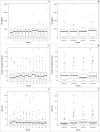Time-series analysis of ruminant foetal wastage at a slaughterhouse in North Central Nigeria between 2001 and 2012
- PMID: 26842363
- PMCID: PMC8552305
- DOI: 10.4102/ojvr.v82i1.1010
Time-series analysis of ruminant foetal wastage at a slaughterhouse in North Central Nigeria between 2001 and 2012
Abstract
In developing countries, foetal wastage from slaughtered ruminants and the associated economic losses appear to be substantial. However, only a limited number of studies have comprehensively evaluated these trends. In the current study, secondary (retrospective) and primary data were collected and evaluated to estimate the prevalence of foetal wastage from cattle, sheep and goats slaughtered at an abattoir in Minna, Nigeria, over a 12-year period (January 2001-December 2012). Time-series modelling revealed substantial differences in the rate of foetal wastage amongst the slaughtered species, with more lambs having been wasted than calves or kids. Seasonal effects seem to influence rates of foetal wastage and certain months in the year appear to be associated with higher odds of foetal wastage. Improved management systems are suggested to reduce the risk of foetal losses.
Figures










References
-
- Abassa, K.P., 1995, ’Prenatal wastage’, in Abassa K.P. (ed.), Reproductive losses in small ruminants in sub-Saharan Africa: A review, working document, International Livestock Centre for Africa (ILCA), Addis Ababa, viewed 18 April 2014, from http://www.ilri.org/InfoServ/Webpub/fulldocs/X5460E/x5460e03.htm#chapter...
-
- Alade, N., Sadisu, M. & Gambo, M., 2011, ‘Incidence of slaughtering pregnant cows, sheep, goats and camels in a Sahel Region of Nigeria’, Research Opinions in Animal and Veterinary Sciences 1, 516–520.
-
- Alhaji, N.B. & Odetokun, I.A., 2013, ‘Food security and economic implications of small ruminant fetal wastages in Nigeria: A case of an abattoir’, Livestock Research for Rural Development 25(5), Article 79, n.p.
MeSH terms
LinkOut - more resources
Full Text Sources
